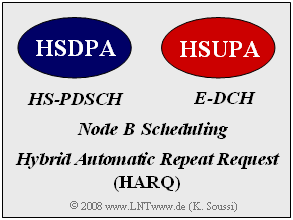Exercise 4.8: HSDPA and HSUPA
To achieve better quality of service, the UMTS Release 99 standard was further developed.
The most important further developments were:
- UMTS Release 5 with $\rm HSDPA$ $($2002$)$,
- UMTS Release 6 with $\rm HUDPA$ $($2004$)$.
Collectively, these developments are known as »High-Speed Packet Access« $\rm (HSPA)$.
The chart shows some of the features of HSDPA and HSUPA that particularly contribute to the increase in performance:
- Both use »Hybrid Automatic Repeat Request« $\rm (HARQ)$ and »Node B Scheduling«.
- With HSDPA, the high-speed transport channel »HS-PDSCH« $($"High-Speed Physical Downlink Shared Channel"$)$ was newly introduced, which is shared by multiple users and allows simultaneous transmission of the same data to many subscribers.
- In the HSUPA standard, there is the additional transport channel »Enhanced Dedicated Channel« $($E-DCH$)$. Among other things, this minimizes the negative impact of applications with very intensive or highly varying data volumes.
- In HSPA, adaptive modulation and coding is used; the transmission rate is adjusted accordingly.
- In good conditions, a $\text{16-QAM}$ $(4$ bit per symbol$)$ or $\text{64-QAM}$ $(6$ bit per symbol$)$ is used, in worse conditions only $\text{4-QAM (QPSK)}$.
- The maximum achievable bit rate depends on receiver performance, but also on "transport format and resource combinations" $\text{(TFRC)}$.
Of the ten specified TFRC classes, only a few are listed here arbitrarily:
- $\text{TFRC2:}$ $\text{4-QAM (QPSK)}$ with code rate $R_{\rm C} =1/2$ ⇒ bit rate: $240 \hspace{0.15cm} \rm kbit/s$,
- $\text{TFRC4:}$ $\text{16-QAM}$ with code rate $R_{\rm C} =1/2$ ⇒ bit rate: $480 \hspace{0.15cm} \rm kbit/s$,
- $\text{TFRC8:}$ $\text{64-QAM}$ with code rate $R_{\rm C} =3/4$ ⇒ bit rate: $1080 \hspace{0.15cm} \rm kbit/s$.
Other TFRC classes are discussed in the subtasks (4) and (5) .
Hints:: This exercise belongs to the chapter "Further Developments of UMTS".
Questions
Solution
(1) Correct is solution 2:
- For conventional UMTS, the data transfer rate is between $144 \ \rm kbit/s$ and $2 \ \rm Mbit/s$.
- For HSDPA $($the abbreviation stands for "High-Speed Downlink Packet Access"$)$, data rates between $500 \ \rm kbit/s$ and $3.6 \ \rm Mbit/s$ are specified, and as a limit even $14.4 \ \rm Mbit/s$.
- HSUPA $($"High-Speed Uplink Packet Access"$)$ refers to the uplink channel, which always has a lower data rate than the downlink. In practice, data rates up to $800 \ \rm kbit/s$ are achieved, the theoretical limit being $5.8 \ \rm Mbit/s$.
(2) The first two statements are correct:
- For a detailed description of the HARQ procedure, see the "theory section".
- In contrast, statement 3 is not correct. The "diagram" in the theory part rather shows that for $10 \cdot {\rm lg}\ E_{\rm B}/N_{0} = 0 \ \rm dB$ $($AWGN channel$)$ the data rate can be increased from $600 \ \rm kbit/s$ to nearly $800 \ \rm kbit/s$.
- Below $-2 \ \rm dB$, a usable transmission is only possible with HARQ. In contrast, for good channels $(E_{\rm B}/N_{0} > 2 \ \rm dB)$, HARQ is not required.
(3) All statements are correct. For further guidance on "Node B Scheduling", see "theory section".
(4) The bit rate $R_{\rm B}\hspace{0.15cm} \underline{= 360 \ \rm kbit/s}$ is larger than the bit rate of TFRC2 by a factor $(3/4)/(1/2) = 1.5$ because of the larger code rate.
(5) With the code rate $R_{\rm C} =1$, QPSK $(2 \ \rm bit \ per \ symbol)$ would result in the bit rate $480 \ \rm kbit/s$.
- For $\text{64-QAM}$ $(6 \ \rm bit \ per \ symbol)$ the value is three times: $R_{\rm B} \hspace{0.15cm}\underline{= 1440 \ \rm kbit/s}$.
